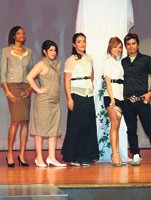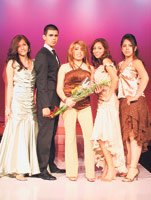Getting an Early Start on a Fashion Career
For Kaleng Taing, launching a career in fashion design was part of a domino effect that started when she was a teenager. Her job, as assistant designer at childrenswear brand Matti & Me, came naturally from her studies at the Fashion Institute of Design & Merchandising in downtown Los Angeles, which she says was a natural progression after graduating from L.A.’s only fashion-based “magnet” school.
Vocational courses such as sewing and wood shop were once standard fare at public high schools before budget cuts eliminated most non-academic courses. In their place are magnet schools that give students training in specific fields in addition to their college-prep classes.
Launched in 1991, the Fashion Career Center—part of the Los Angeles Unified School District and located at the Downtown Magnets High School—boasts 125 students who often endure long bus rides to learn sewing and sketching, along with their required math and English classes.
Taing, who graduated from the program in 2000, knew at an early age that she wanted to work in the fashion industry. As a student at the Fashion Career Center, an introduction to FIDM representatives was automatic, said Taing, who eventually earned a scholarship to the fashion institute. Taing believes her magnet school training gave her an edge on her FIDM classmates, since she could already sew and had designed and constructed a clothing collection as part of her senior project.
But not all Fashion Career Center students are as driven and focused as Taing, says department chair and course instructor Barbara Rain. Students are admitted to the program primarily by lottery, she said. “It’s not by audition, and they don’t have to submit any kind of portfolio, and that’s one of the problems I have with it,” Rain said, “because I think that the kids who come should really be interested, and you can tell when they’re not.”
“I wish we had maybe more of a screening process,” she added, “but it is a public school, so we really can’t do that.”
The Fashion Career Center operates like a regular high school, except that students take fashion classes—perhaps only one per semester— for their electives. Although the student body is as ethnically diverse as Los Angeles, only a few boys are in the program, Rain said. The students learn sewing on industrial power machines; how to create garments from commercial patterns; and sketching, design and color theory. They also can get work-experience internships at downtown showrooms.
Each year, senior students present their work in a fashion show. Beforehand, judges from the fashion industry rate the collections and give out awards in several categories. Woodbury University also offers a scholarship to the student with the best collection.
This year, FCC students presented their annual show, dubbed “Beyond the Runway,” at Los Angeles Trade-Technical College on May 13. “Project Runway” designer/contestant Raymundo Baltzar was on hand to address the students.
Student designer Erica Gonzales won the Outstanding Technical Achievement award, as well as the Woodbury Prize, with her Elegant Night collection. And student designer Jessica Alonso won Best Overall Collection for her “Party Time” designs.
Not surprisingly, the students who do best at the Fashion Career Center tend to be those who excel in math and English, as well as the fashion courses. The program is not intended to serve as a vocational school that will prepare students to find a fashion-industry job directly out of high school. “I don’t think any of them could immediately step into the industry after the program,” said Rain. The occasional exception occurs when a student is hired as a sales assistant in the showroom where she interned.
What the school does best is better prepare students—such as Taing—to go on to study fashion design in college.
“I wanted to go to college for sure,” said Taing. “I knew I wasn’t going to get work right after high school. hellip; But we learned a lot [at the Fashion Career Center],” she added. “And compared with other 18-yearolds, we got to do fashion shows.”
























